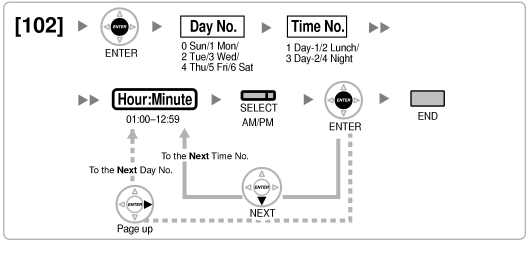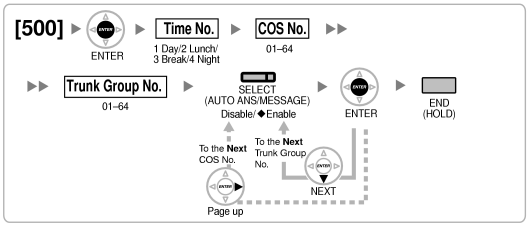2.1 PT Programming
2.1.1 Programming Instructions
Required Telephone/Extension
| PBX settings can be customized through system programming by using a proprietary telephone (PT) with a multiline display, such as the KX-NT343 or KX-NT346. To access system programming, the Class of Service (COS) assigned to the PT's extension must be programmed to allow system programming, or the PT must be connected to the lowest-numbered port on the card installed in the lowest-numbered slot. |
| Only one system programming session can be performed at a time. This means that only one user can access system programming at a time, whether through a PT or PC. |
| For a list of characters that can be entered during system programming, see Section 1.1.3 Entering Characters. |
|
Buttons and Functions
|
|
Fixed Buttons |
Function | |
KX-NT300 |
KX-NT136/KX-T7600 |
KX-T7200/KX-T7400* | |
|
|
|
| |
|
|
|
| |
|
|
|
 |
| (Page up) |
| |
|
|
|
 |
| (Page down) |
| |
|
|
|
| |
|
|
|
| Back to Previous Menu |
| (CANCEL) |
| |
|
|
|
| |
|
|
|
| |
|
|
|
| |
|
|
|
| |
|
|
|
| |
|
|
|
| |
|
|
|
|
|
|
|
| The buttons shown in this column are from the KX-T7400 series. |
|
Entering System Programming Mode
Using a PT to perform system programming allows an authorized extension user to set a wide range of PBX features and parameters.
There are two levels of system programming that can be performed with a PT: administrator-level programming and user-level programming. |
Administrator Level:
Allows the programming of all settings accessible through PT programming. |
|
|
User Level:
Allows the programming of limited settings as permitted through PC programming. |
|
|
Note
|
 means default value throughout this manual. means default value throughout this manual. |
|
Programming Structure
|
Programming Number |
Programming Group Title |
Description | |
|
|
| Frequently used programming steps |
| |
|
| System Management Programming |
|
| |
|
|
| |
|
|
| TRS and Automatic Route Selection (ARS) programming |
| |
|
|
| CO line and trunk group settings |
| |
|
|
| Class of Service parameters |
| |
|
|
| Extension feature settings |
| |
|
| Resource/Interface Programming |
|
| PBX interface and external device settings |
| |
|
| SMDR & Maintenance Programming |
|
| Station Message Detail Recording (SMDR) and maintenance feature settings |
| |
|
|
| Used to display the cards currently installed in the PBX, or to delete a card from system programming before physically removing it. |
|
|
2.1.2 Maximum Values
| Throughout this manual, maximum entry values are shown for each programming item, as shown in the example below. |
| However, please note that slot and port entry values are not listed within each programming item. These values vary depending on the model of PBX and the card type installed, as shown below. |
|
Available Slot Entry Values
|
|
PBX Model |
Free Slot Number |
Supported Cards | |
|
|
| |
|
|
|
Enter slot numbers as two-digit numbers (e.g. "04" for slot 4).
|
|
Available Port Entry Values
|
|
Card Type |
Port Number |
Related Programming | |
|
|
| |
|
| |
|
| |
|
|
| |
|
|
| |
|
|
|
| Enter values as two-digit numbers (e.g. "04" for port 4). |
|
|
| Enter card number and port number as single-digit numbers (e.g. "34" for card 3, port 4). |
|
|
2.1.3 Basic Programming
[001] System Speed Dialing Number
[002] System Speed Dialing Name
[003] Extension Number
Notes
|
• |
Extension numbers of PSs can be a maximum of 4 digits. |
|
• |
If PC Phone, PC Console, or a CTI application is running on a PC connected to an extension whose extension number is to be programmed/modified, quit the application first. |
[005] Extension Personal Identification Number (PIN)
|
|
WARNING
|
There is a risk that fraudulent telephone calls will be made if a third party discovers a personal identification number (PIN) (verification code PIN or extension PIN) of the PBX.
The cost of such calls will be billed to the owner/renter of the PBX.
To protect the PBX from this kind of fraudulent use, we strongly recommend: |
|
| a) |
Keeping PINs secret. |
| b) |
Selecting complex, random PINs that cannot be easily guessed. |
| c) |
Changing PINs frequently. |
|
[006] Operator Assignment
[007] DSS Console Paired Telephone
Note
|
This program is only available after the port connected to the DSS Console is assigned as "DSS Console" in [601] Terminal Device Assignment.
Note that if one or more SDN buttons have been set at the DSS Console, they must be deleted before this setting can be changed. |
2.1.4 System Management Programming
[101] Time Service Switching Mode
[102] Time Service Starting Time
[103] Idle Line Access (Local Access)
[110] System Password for Administrator—for PT Programming
[111] System Password for User—for PT Programming
[121] Verification Code Name
[122] Verification Code Personal Identification Number (PIN)
|
|
WARNING
|
There is a risk that fraudulent telephone calls will be made if a third party discovers a personal identification number (PIN) (verification code PIN or extension PIN) of the PBX.
The cost of such calls will be billed to the owner/renter of the PBX.
To protect the PBX from this kind of fraudulent use, we strongly recommend: |
|
| a) |
Keeping PINs secret. |
| b) |
Selecting complex, random PINs that cannot be easily guessed. |
| c) |
Changing PINs frequently. |
|
[123] Verification Code COS Number
[190] Main Processing (MPR) Software Version Reference
2.1.5 Timer Programming
[201] Transfer Recall Time
[204] Hot Line Waiting Time
[205] Automatic Redial Repeat Times
[208] Call Duration Count Starting Time for LCOT
[209] DISA Delayed Answer Time
[210] DISA CO-to-CO Line Call Prolong Time
[211] DISA Intercept Time
2.1.6 TRS/ARS Programming
[300] TRS Override by System Speed Dialing
[303] Special Carrier Access Code
[322] ARS Routing Plan Table Number
[325] ARS Exception Number
[330] ARS Routing Plan Time Table
[331–346] ARS Routing Plan Table (1–16)
|
|
|
|
| For programs [331] to [340], when Priority 1 is selected, the default value of Carrier Table No. is as follows: |
|
|
|
| [331]: 01, [332]: 02, [333]: 03, [334]: 04, [335]: 05, |
|
|
|
| [336]: 06, [337]: 07, [338]: 08, [339]: 09, [340]: 10 |
|
|
[351] ARS Trunk Group for Carrier Access
[352] ARS Removed Number of Digits for Carrier Access
[353] ARS Carrier Access Code
2.1.7 CO Line Programming
[400] LCOT CO Line Connection
[402] LCOT Trunk Group Number
[409] LCOT CO Line Number Reference
[412] LCOT DTMF Minimum Duration
[413] LCOT CPC Signal Detection Time—Outgoing
[414] LCOT CPC Signal Detection Time—Incoming
[417] LCOT Flash/Recall Time
[418] LCOT Disconnect Time
[450] DIL 1:1 Destination
[471] Host PBX Access Code
[472] Extension-to-CO Line Call Duration
[473] CO-to-CO Line Call Duration
[475] DISA Silence Detection
[476] DISA Continuous Signal Detection
[477] DISA Cyclic Signal Detection
[490] Caller ID Signal Type
2.1.8 COS Programming
[502] CO Line Call Duration Limitation
[503] Call Transfer to CO Line
[504] Call Forwarding to CO Line
[505] Executive Busy Override
[506] Executive Busy Override Deny
[509] TRS Level for System Speed Dialing
[510] TRS Level for Extension Dial Lock
[512] Permission for Door Open Access
[514] Time Service Manual Switching
[515] Wireless XDP Parallel Mode for Paired Telephone
[516] Programming Mode Limitation
2.1.9 Extension Programming
[600] EXtra Device Port (XDP) Mode
[601] Terminal Device Assignment
Note
|
When changing the type of a port for which one or more SDN buttons are set (except when changing between PC Console and Telephone), all SDN buttons customized for that device will be deleted. |
[603] Extension User Group
[604] Extension Intercept Destination
[605] Call Forwarding—No Answer Time
[620] Incoming Call Distribution Group Member
[621] Incoming Call Distribution Group Delayed Ringing
[622] Incoming Call Distribution Group Floating Extension Number
[623] Incoming Call Distribution Group Name
[624] Incoming Call Distribution Group Distribution Method
[625] Destination for Overflow Time Expiration
[627] Destination When All Busy
[628] Queuing Call Capacity
[629] Queuing Hurry-up Level
[631] Sequences in Queuing Time Table
[632] Maximum Number of Agents
[640] Extension User Groups of a Paging Group
[641] External Pagers of a Paging Group
[650] Extension User Groups of a Pickup Group
[660] VM Group Floating Extension Number
[680] Idle Extension Hunting Type
[681] Idle Extension Hunting Group Member
[690] PS Registration
|
|
Note
|
Please refer to the Installation Manual for details about PS registration. |
|
|
|
[692] Personal Identification Number (PIN) for PS Registration
[699] CS Status Reference
2.1.10 Resource/Interface Programming
[700] External Pager Floating Extension Number
[710] Music Source Selection for BGM1/BGM2
[720] Doorphone Call Destination
[729] Doorphone Number Reference
[730] Outgoing Message (OGM) Floating Extension Number
[731] Outgoing Message (OGM) Name
2.1.11 SMDR & Maintenance Programming
[800] RS-232C Parameter—New Line Code
[800] RS-232C Parameter—Baud Rate
[800] RS-232C Parameter—Word Length
[800] RS-232C Parameter—Parity Bit
[800] RS-232C Parameter—Stop Bit Length
[801] External Modem Control
[803] SMDR Skip Perforation
[804] SMDR Outgoing Call Printing
[805] SMDR Incoming Call Printing
[811] Modem Floating Extension Number
[812] ISDN Remote Floating Extension Number
2.1.12 Card Programming
[900] Slot Card Type Reference
[910] OPB3 Option Card Type Reference
[911] OPB3 Option Card Deletion

















































































































































